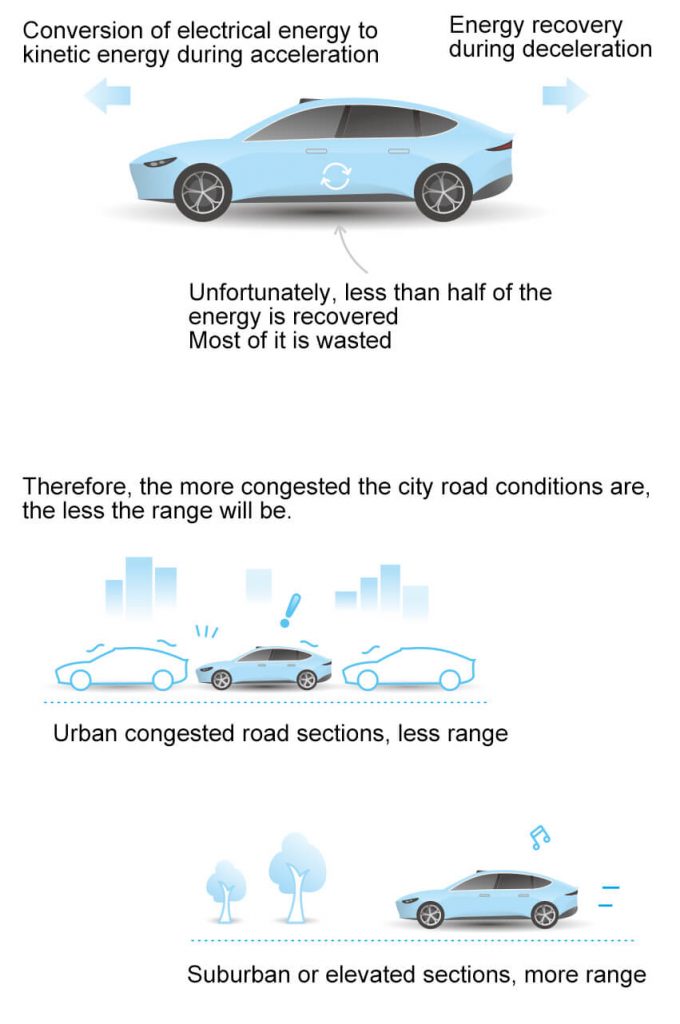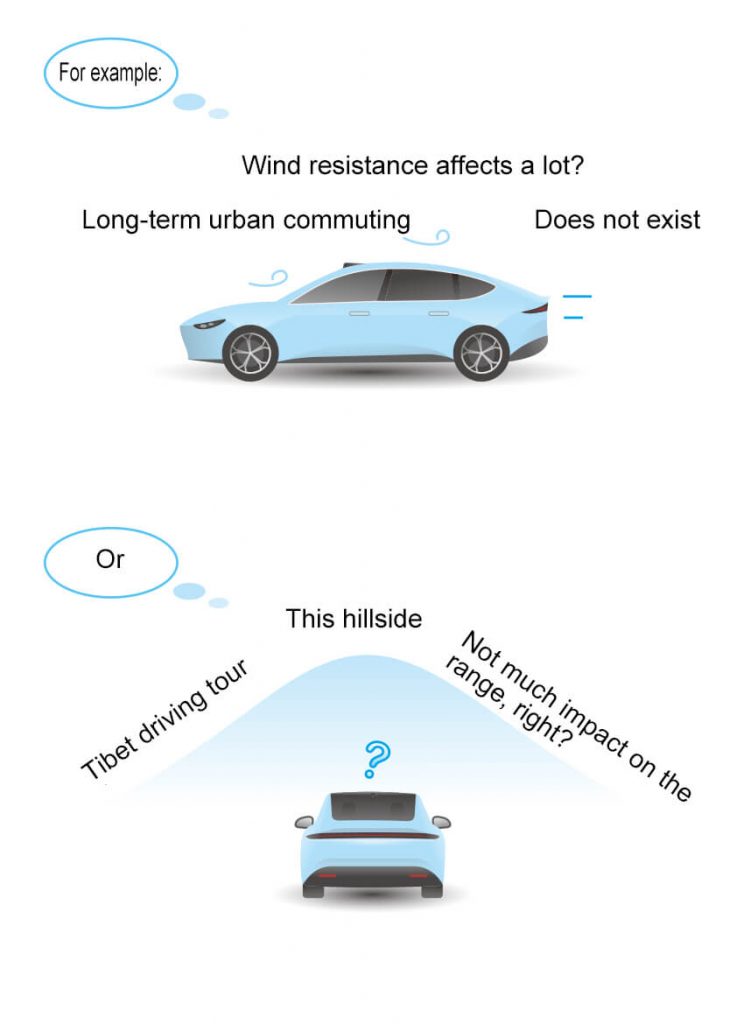Why Is The Range Of Electric Vehicles Always Not Enough?
The Cruising Range Of Electric Vehicles Has Been Continuously Improved, From Two To Three Hundred Kilometers In The Past Few Years To More Than 600 Kilometers At Present, But It Still Cannot Meet The Needs. Why?

There Are Two Main Reasons: Charging Is Inconvenient, And Battery Life Is Not Durable. Just Because Charging Is Inconvenient, It Also Highlights The Importance Of Battery Life. So Here Comes The Question: Why Is The Battery Life Not Durable? Answer: Because There Are Too Many Factors That Affect Battery Life.
Various Factors Affecting Cruising Range
There Are Many Influencing Factors, Which Are Introduced In Order Of Importance As Follows:
1. Wind Resistance (i.e. Air Resistance)
Vehicles Need To Overcome Wind Resistance, This Part Of Energy Cannot Be Recovered, And Wind Resistance Is Proportional To The Square Of Speed, So Wind Resistance Has A Great Impact On Battery Life, Especially At High Speeds.
Because Of This, The Focus Of The Exterior Design Of Pure Electric Vehicles Is To Reduce Wind Resistance.

The Wind Resistance Is Measured By The Drag Coefficient, Which Is Determined By The Exterior Design Of The Vehicle. The Greater The Drag Coefficient, The Greater The Air Resistance When Driving. The Drag Coefficient Of Electric Vehicles Is Between 0.2-0.3, And The Drag Coefficient Can Be Reduced By 0.001, And The Cruising Range Can Be Increased By 10-20 Kilometers.

In The Actual Use Of The Car, The Effects Related To Wind Resistance Are As Follows:
① Various External Installations Or Trailers Will Increase Wind Resistance And Reduce Battery Life, So Careful Consideration Is Required.

② Relatively Speaking, Suvs Have Greater Wind Resistance Than Cars, And The Reduction In Battery Life At High Speeds Is Greater.

2. Driving Speed
In Addition To The Relationship Between Speed And Wind Resistance Mentioned Above, The Impact Of Speed On Battery Life Has The Following Two Points:
① The Motor Has A High-efficiency Working Range. If The Speed Is Too High Or Too Low, More Energy Will Be Wasted, Thereby Reducing Battery Life.

② The Faster The Driving Speed, The Greater The Discharge Current, Which Will Reduce The Total Discharge Capacity Of The Battery And Reduce The Battery Life.

Based On The Influence Of Wind Resistance And Driving Speed On The Cruising Range, The Cruising Curve Can Be Obtained:


Disclaimer: The Above Speed Data Only Represent The Overall Law, And There Will Be Some Differences In The Data Of Different Models.
3. Degree Of Congestion
The Actual Driving Of The Vehicle Is To Continuously Repeat Acceleration And Deceleration, And The Energy Loss In The Process Is Relatively Large, Resulting In A Reduction In Battery Life. Therefore, The More Congested The Urban Road Conditions Are, The Less Battery Life Will Be.

But Pay Attention: On High-speed Roads With More Traffic, Due To The Decrease In Driving Speed And Reduced Wind Resistance, The Cruising Range Will Be Longer Than Smooth High-speed Driving, And Of Course The Driving Time Will Also Be Longer.

4. Driving Intensity
The Impact Of Driving Intensity On Battery Life Is Similar To That Of Congestion, And May Even Have A Greater Impact. Rapid Acceleration And Then Sudden Braking, The More Energy Wasted, The Less Battery Life.

5. Temperature
Temperature Has Two Effects On Battery Life:
① The Battery Activity Decreases At Low Temperature, And The Discharge Capacity Will Be Significantly Reduced. It Will Get Better Through Self-heating, But It Still Loses More Energy, So The Lower The Temperature, The Less Battery Life.

② If the temperature is too high or too low, it will increase the power consumption of the air conditioner in the car, thereby reducing the battery life of the vehicle.

1) 25°c Is The Best Temperature, High Or Low Will Affect Battery Life.
2) The Battery Life In The North Is The Lowest In Winter, And The Battery Life In The South Is The Lowest In Summer.
3) When The Power Is Very Low, Consider Turning Off The Air Conditioner For Driving.
6. Rainwater
Rain Will Increase The Driving Resistance Of The Vehicle, So The Battery Life In Rainy Days Will Be Reduced, Especially When Driving At High Speeds.

7. Uphill and downhill
In the uphill section, in addition to overcoming the driving resistance, gravity also needs to be overcome, and a part of the electric energy will be converted into the gravitational potential energy of the vehicle, so the battery life is reduced. The opposite is true for downhill sections.

8. Vehicle Load
① As The Load Increases, The Rolling Resistance Of Driving Will Also Increase, And The Consumed Energy Cannot Be Recovered.

② As The Load Increases, More Electrical Energy Is Required To Be Converted Into Kinetic Energy During Acceleration, And Part Of This Energy Can Be Recovered.

9. Wheels And Tires
Simply Put, The Larger The Wheel, The Greater The Driving Resistance And The Less Battery Life. For Every Inch Added To The Hub, The Battery Life Will Be Reduced By About 3-5%. It Is Also Necessary To Pay Attention To Changing Tires. The Wider The Tire, The Greater The Resistance And The Reduced Battery Life.

10. Tire Pressure
If The Tire Pressure Is Reduced, The Contact Area Between The Tire And The Ground Increases, The Driving Resistance Also Increases, And The Battery Life Will Be Reduced. On The Contrary, The Increase In Tire Pressure Increases The Battery Life.

However, If The Tire Pressure Is Too High, The Grip Of The Tires Will Be Reduced, Which Will Affect The Handling Performance And Driving Safety.

Please Pay Attention To Keep The Tire Pressure In The Appropriate Range For Daily Use Of The Car. Before A Long-distance Trip, You Can Properly Increase The Tire Pressure To Increase The Battery Life.
The Degree Of Influence Of Each Factor
1. Wind Resistance: Great Influence
2. Driving Speed: Great Influence
3. Congestion Degree: Large Impact
4. Driving Intensity: Great Influence
5. Temperature: Great Influence
6. Rainwater: Under Influence
7. Uphill And Downhill: Under Influence
8. Vehicle Load: Under Influence
9. Wheels And Tires: Little Impact
10. Tire Pressure: Little Effect
Note: The Degree Of Impact Above Is Roughly Evaluated Based On Common Scenarios And Is For Reference Only. In The Actual Use Of The Car, The Degree Of Influence Of Each Factor Will Also Change.




